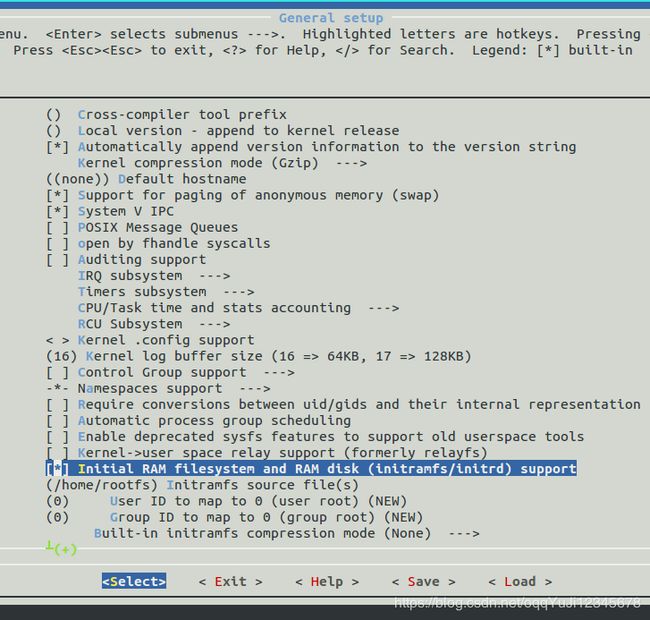linux initramfs启动原理
当linux选择支持initramfs方式启动,并且在initramfs source file中选择了要打包的rootfs路径以后,则会尝试以initramfs方式启动。initramfs方式会对rootfs进行压缩,和linux kernel打包在同一个镜像文件中。然后系统加载的时候uboot会把整个镜像文件都加载到内存中。以该种方式加载的rootfs,是没办法修改flash中rootfs的数据的,掉电即会丢失。具体的kernel 配置类似如下:
下面我们分析一下具体的加载过程。
系统初始化的时候,在init进程中又如下调用:
kernel_init
---------->kernel_init_freeable
--------------->do_basic_setup
----------------->do_initcalls
在do_initcalls中主要完成linux各个驱动模块的初始化。其中有个函数populate_rootfs,他是如此定义的:
rootfs_initcall(populate_rootfs);
#define fs_initcall(fn) __define_initcall(fn, 5)
#define fs_initcall_sync(fn) __define_initcall(fn, 5s)
#define rootfs_initcall(fn) __define_initcall(fn, rootfs)
#define device_initcall(fn) __define_initcall(fn, 6)
该函数最终也会被do_initcalls调用到。看一下populate_rootfs的具体定义:
static int __init populate_rootfs(void)
{
char *err = unpack_to_rootfs(__initramfs_start, __initramfs_size);
if (err)
panic(err); /* Failed to decompress INTERNAL initramfs */
if (initrd_start) { //initrd_start为0,所以下面这支不会走到
#ifdef CONFIG_BLK_DEV_RAM
int fd;
printk(KERN_INFO "Trying to unpack rootfs image as initramfs...\n");
err = unpack_to_rootfs((char *)initrd_start,
initrd_end - initrd_start);
if (!err) {
free_initrd();
goto done;
} else {
clean_rootfs();
unpack_to_rootfs(__initramfs_start, __initramfs_size);
}
printk(KERN_INFO "rootfs image is not initramfs (%s)"
"; looks like an initrd\n", err);
fd = sys_open("/initrd.image",
O_WRONLY|O_CREAT, 0700);
if (fd >= 0) {
sys_write(fd, (char *)initrd_start,
initrd_end - initrd_start);
sys_close(fd);
free_initrd();
}
done:
#else
printk(KERN_INFO "Unpacking initramfs...\n");
err = unpack_to_rootfs((char *)initrd_start,
initrd_end - initrd_start);
if (err)
printk(KERN_EMERG "Initramfs unpacking failed: %s\n", err);
free_initrd();
#endif
/*
* Try loading default modules from initramfs. This gives
* us a chance to load before device_initcalls.
*/
load_default_modules();
}
return 0;
}__initramfs_start是压缩的rootfs的起始地址,__initramfs_size是rootfs的大小。unpack_to_rootfs函数负责把rootfs中的文件一个个解压出来。系统初始化的时候,在调用init函数之前,就已经把根文件系统初始化好了,他是个基于ramfs的文件系统。所以这边解压这个压缩的rootfs的时候,就是把rootfs中的文件,挨个写到之前系统初始化好的根文件系统中。ramfs文件系统的读写原理可以参考这篇文章:
https://blog.csdn.net/oqqYuJi12345678/article/details/103192290
下面来大概看一下unpack_to_rootfs这个函数:
static char * __init unpack_to_rootfs(char *buf, unsigned len)
{
int written, res;
decompress_fn decompress;
const char *compress_name;
static __initdata char msg_buf[64];
header_buf = kmalloc(110, GFP_KERNEL);
symlink_buf = kmalloc(PATH_MAX + N_ALIGN(PATH_MAX) + 1, GFP_KERNEL);
name_buf = kmalloc(N_ALIGN(PATH_MAX), GFP_KERNEL);
if (!header_buf || !symlink_buf || !name_buf)
panic("can't allocate buffers");
state = Start;
this_header = 0;
message = NULL;
while (!message && len) {
loff_t saved_offset = this_header;
if (*buf == '0' && !(this_header & 3)) {
state = Start;
written = write_buffer(buf, len);
buf += written;
len -= written;
continue;
}
if (!*buf) {
buf++;
len--;
this_header++;
continue;
}
this_header = 0;
decompress = decompress_method(buf, len, &compress_name);//根据获取的文件头中的信息,判断这个文件的压缩方式,获取解压函数集
if (decompress) {
//解压
res = decompress(buf, len, NULL, flush_buffer, NULL,
&my_inptr, error);
if (res)
error("decompressor failed");
} else if (compress_name) {
if (!message) {
snprintf(msg_buf, sizeof msg_buf,
"compression method %s not configured",
compress_name);
message = msg_buf;
}
} else
error("junk in compressed archive");
if (state != Reset)
error("junk in compressed archive");
this_header = saved_offset + my_inptr;
buf += my_inptr;
len -= my_inptr;
}
dir_utime();
kfree(name_buf);
kfree(symlink_buf);
kfree(header_buf);
return message;
}上面函数最终会在ramfs 根文件系统中创建rootfs压缩包中的每个文件。
这个时候我们的rootfs就已经准备好了。
在kernel_init_freeable函数中:
static noinline void __init kernel_init_freeable(void)
{
/*
* Wait until kthreadd is all set-up.
*/
wait_for_completion(&kthreadd_done);
/* Now the scheduler is fully set up and can do blocking allocations */
gfp_allowed_mask = __GFP_BITS_MASK;
/*
* init can allocate pages on any node
*/
set_mems_allowed(node_states[N_MEMORY]);
/*
* init can run on any cpu.
*/
set_cpus_allowed_ptr(current, cpu_all_mask);
cad_pid = task_pid(current);
smp_prepare_cpus(setup_max_cpus);
do_pre_smp_initcalls();
lockup_detector_init();
smp_init();
sched_init_smp();
do_basic_setup();
/* Open the /dev/console on the rootfs, this should never fail */
if (sys_open((const char __user *) "/dev/console", O_RDWR, 0) < 0)
pr_err("Warning: unable to open an initial console.\n");
(void) sys_dup(0);
(void) sys_dup(0);
/*
* check if there is an early userspace init. If yes, let it do all
* the work
*/
if (!ramdisk_execute_command)//没有设置ramdisk_execute_command,就设置ramdisk_execute_command为"/init"
ramdisk_execute_command = "/init";
//判断/init是否存在,不存在ramdisk_execute_command被置为空
if (sys_access((const char __user *) ramdisk_execute_command, 0) != 0) {
ramdisk_execute_command = NULL;
prepare_namespace();
}
/*
* Ok, we have completed the initial bootup, and
* we're essentially up and running. Get rid of the
* initmem segments and start the user-mode stuff..
*/
/* rootfs is available now, try loading default modules */
load_default_modules();
}该函数中对ramdisk_execute_command初始化。在initramfs方式启动时,需要在rootfs压缩包中包含/init文件。经过上面的过程,ramdisk_execute_command 最终被设置为/init。一般init文件是个链接:
lrwxrwxrwx 1 lu lu 11 Jun 29 05:59 init -> bin/busybox*最后一切准备完毕以后,会调用/init完成最后的初始化工作:
static int __ref kernel_init(void *unused)
{
printk(KERN_INFO " kernel_init.\n");
kernel_init_freeable();
/* need to finish all async __init code before freeing the memory */
async_synchronize_full();
free_initmem();
mark_rodata_ro();
system_state = SYSTEM_RUNNING;
numa_default_policy();
flush_delayed_fput();
if (ramdisk_execute_command) {//在这边执行init程序,kernel_init程序一去不复返了
if (!run_init_process(ramdisk_execute_command))
return 0;
pr_err("Failed to execute %s\n", ramdisk_execute_command);
}
/*
* We try each of these until one succeeds.
*
* The Bourne shell can be used instead of init if we are
* trying to recover a really broken machine.
*/
if (execute_command) {
if (!run_init_process(execute_command))
return 0;
pr_err("Failed to execute %s. Attempting defaults...\n",
execute_command);
}
if (!run_init_process("/sbin/init") ||
!run_init_process("/etc/init") ||
!run_init_process("/bin/init") ||
!run_init_process("/bin/sh"))
return 0;
panic("No init found. Try passing init= option to kernel. "
"See Linux Documentation/init.txt for guidance.");
}
